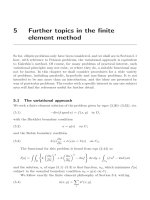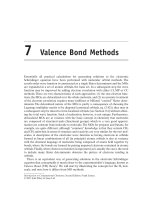Ebook Mobile AD hoc networking (2nd edition) Part 2
Bạn đang xem bản rút gọn của tài liệu. Xem và tải ngay bản đầy đủ của tài liệu tại đây (8.47 MB, 468 trang )
MOBILE AD HOC
NETWORKING
ieee ed board_grid.qxd 1/8/2013 7:52 AM Page 1
IEEE Press
445 Hoes Lane
Piscataway, NJ 08854
IEEE Press Editorial Board 2013
John Anderson, Editor in Chief
Linda Shafer
George W. Arnold
Ekram Hossain
Om P. Malik
Saeid Nahavandi
David Jacobson
Mary Lanzerotti
George Zobrist
Tariq Samad
Dmitry Goldgof
Kenneth Moore, Director of IEEE Book and Information Services (BIS)
MOBILE AD HOC
NETWORKING
Cutting Edge Directions
Second Edition
Edited by
STEFANO BASAGNI
MARCO CONTI
SILVIA GIORDANO
IVAN STOJMENOVIC
Cover Design: John Wiley & Sons, Inc.
Cover Photographs: Top inset photo: © John Wiley & Sons
Bottom inset photo: © merrymoonmary/iStockphoto
Copyright © 2013 by The Institute of Electrical and Electronics Engineers, Inc.
Published by John Wiley & Sons, Inc., Hoboken, New Jersey. All rights reserved
Published simultaneously in Canada
No part of this publication may be reproduced, stored in a retrieval system, or transmitted in any form
or by any means, electronic, mechanical, photocopying, recording, scanning, or otherwise, except as
permitted under Section 107 or 108 of the 1976 United States Copyright Act, without either the prior
written permission of the Publisher, or authorization through payment of the appropriate per-copy fee
to the Copyright Clearance Center, Inc., 222 Rosewood Drive, Danvers, MA 01923, (978) 750-8400,
fax (978) 750-4470, or on the web at www.copyright.com. Requests to the Publisher for permission
should be addressed to the Permissions Department, John Wiley & Sons, Inc., 111 River Street, Hoboken,
NJ 07030, (201) 748-6011, fax (201) 748-6008, or online at />Limit of Liability/Disclaimer of Warranty: While the publisher and author have used their best efforts
in preparing this book, they make no representations or warranties with respect to the accuracy or
completeness of the contents of this book and specifically disclaim any implied warranties of
merchantability or fitness for a particular purpose. No warranty may be created or extended by sales
representatives or written sales materials. The advice and strategies contained herein may not be suitable
for your situation. You should consult with a professional where appropriate. Neither the publisher nor
author shall be liable for any loss of profit or any other commercial damages, including but not limited to
special, incidental, consequential, or other damages.
For general information on our other products and services or for technical support, please contact our
Customer Care Department within the United States at (800) 762-2974, outside the United States at
(317) 572-3993 or fax (317) 572-4002.
Wiley also publishes its books in a variety of electronic formats. Some content that appears in print may
not be available in electronic formats. For more information about Wiley products, visit our web site at
www.wiley.com.
Library of Congress Cataloging-in-Publication Data:
Mobile ad hoc networking : the cutting edge directions / edited by Stefano
Basagni, Marco Conti, Silvia Giordano, Ivan Stojmenovic. – Second edition.
pages cm.
ISBN 978-1-118-08728-2 (hardback)
1. Ad hoc networks (Computer networks) 2. Wireless LANs. 3. Mobile
computing. I. Basagni, Stefano, 1965- editor of compilation.
TK5105.78.M63 2012
004.6’167–dc23
2012031683
Printed in the United States of America
10 9 8 7 6 5 4 3 2 1
CONTENTS
PREFACE
xiii
ACKNOWLEDGMENTS
CONTRIBUTORS
PART I
1
xv
xvii
GENERAL ISSUES
Multihop Ad Hoc Networking: The Evolutionary Path
3
Marco Conti and Silvia Giordano
1.1
Introduction, 3
1.2
MANET Research: Major Achievements and Lessons Learned, 5
1.3
Multihop Ad Hoc Networks: From Theory to Reality, 16
1.4
Summary and Conclusions, 25
References, 26
2
Enabling Technologies and Standards for Mobile Multihop
Wireless Networking
34
Enzo Mingozzi and Claudio Cicconetti
2.1
2.2
2.3
2.4
Introduction, 35
Broadband Wireless Access Technologies, 37
Wireless Local Area Networks Technologies, 43
Personal Area Networks Technologies, 53
v
vi
CONTENTS
2.5
Mobility Support in Heterogeneous Scenarios, 65
2.6
Conclusions, 67
References, 69
3
Application Scenarios
77
Ilias Leontiadis, Ettore Ferranti, Cecilia Mascolo, Liam McNamara,
Bence Pasztor, Niki Trigoni, and Sonia Waharte
3.1
Introduction, 78
3.2
Military Applications, 79
3.3
Network Connectivity, 81
3.4
Wireless Sensor Networks, 84
3.5
Search and Rescue, 89
3.6
Vehicular Networks, 93
3.7
Personal Content Dissemination, 96
3.8
Conclusions, 98
References, 98
4
Security in Wireless Ad Hoc Networks
106
Roberto Di Pietro and Josep Domingo-Ferrer
4.1
Introduction, 106
4.2
Wireless Sensor Networks, 110
4.3
Unattended WSN, 125
4.4
Wireless Mesh Networks, 130
4.5
Delay-Tolerant Networks, 134
4.6
Vehicular Ad Hoc Networks (VANETs), 137
4.7
Conclusions and Open Research Issues, 144
References, 144
5
Architectural Solutions for End-User Mobility
154
Salvatore Vanini and Anna F¨orster
5.1
Introduction, 154
5.2
Mesh Networks, 155
5.3
Wireless Sensor Networks, 182
5.4
Conclusion, 188
References, 188
6
Experimental Work Versus Simulation in the Study
of Mobile Ad Hoc Networks
Carlo Vallati, Victor Omwando, and Prasant Mohapatra
6.1
6.2
6.3
Introduction, 191
Overview of Mobile Ad Hoc Network Simulation Tools
and Experimental Platforms, 192
Gap Between Simulations and Experiments: Issues
and Factors, 199
191
vii
CONTENTS
6.4
Good Simulations: Validation, Verification, and
Calibration, 220
6.5
Simulators and Testbeds: Future Prospects, 226
6.6
Conclusion, 228
References, 228
PART II
7
MESH NETWORKING
Resource Optimization in Multiradio Multichannel
Wireless Mesh Networks
241
Antonio Capone, Ilario Filippini, Stefano Gualandi, and Di Yuan
7.1
7.2
7.3
7.4
7.5
7.6
Introduction, 242
Network and Interference Models, 244
Maximum Link Activation Under the SINR Model, 245
Optimal Link Scheduling, 247
Joint Routing and Scheduling, 254
Dealing with Channel Assignment and Directional
Antennas, 257
7.7
Cooperative Networking, 263
7.8
Concluding Remarks and Future Issues, 269
References, 271
8
Quality of Service in Mesh Networks
275
Raffaele Bruno
8.1
8.2
8.3
8.4
Introduction, 275
QoS Definition, 277
A Taxonomy of Existing QoS Routing Approaches, 278
Routing Protocols with Optimization-Based Path
Selection, 280
8.5
Routing Metrics for Minimum-Weight Path Selection, 291
8.6
Feedback-Based Path Selection, 307
8.7
Conclusions, 308
References, 308
PART III
9
OPPORTUNISTIC NETWORKING
Applications in Delay-Tolerant and Opportunistic Networks
Teemu K¨arkk¨ainen, Mikko Pitkanen, and Joerg Ott
9.1
9.2
9.3
Application Scenarios, 318
Challenges for Applications Over DTN, 322
Critical Mechanisms for DTN Applications, 328
317
viii
CONTENTS
9.4
DTN Applications (Case Studies), 336
9.5
Conclusion: Rethinking Applications for DTNs, 357
References, 358
10 Mobility Models in Opportunistic Networks
360
Kyunghan Lee, Pan Hui, and Song Chong
10.1 Introduction, 360
10.2 Contact-Based Measurement, Analysis, and Modeling, 361
10.3 Trajectory Models, 376
10.4 Implications for Network Protocol Design, 399
10.5 New Paradigm: Delay-Resource Tradeoffs, 406
References, 414
11 Opportunistic Routing
419
Thrasyvoulos Spyropoulos and Andreea Picu
11.1 Introduction, 420
11.2 Cornerstones of Opportunistic Networks, 422
11.3 Dealing with Uncertainty: Redundancy-Based Routing, 428
11.4 Capitalizing on Structure: Utility-Based Forwarding, 435
11.5 Hybrid Solutions: Combining Redundancy and Utility, 444
11.6 Conclusion, 447
References, 448
12 Data Dissemination in Opportunistic Networks
453
Chiara Boldrini and Andrea Passarella
12.1 Introduction, 454
12.2 Initial Ideas: PodNet, 456
12.3 Social-Aware Schemes, 460
12.4 Publish/Subscribe Schemes, 464
12.5 Global Optimization, 469
12.6 Infrastructure-Based Approaches, 474
12.7 Approaches Inspired by Unstructured p2p Systems, 478
12.8 Further Readings, 482
References, 486
13 Task Farming in Crowd Computing
Derek G. Murray, Karthik Nilakant, J. Crowcroft, and E. Yoneki
13.1
13.2
13.3
13.4
Introduction, 491
Ideal Parallelism Model, 494
Task Farming, 498
Socially Aware Task Farming, 500
491
ix
CONTENTS
13.5 Related Work, 510
13.6 Conclusions and Future Work, 510
References, 512
PART IV
VANET
14 A Taxonomy of Data Communication Protocols for Vehicular
Ad Hoc Networks
517
Yousef-Awwad Daraghmi, Ivan Stojmenovic, and Chih-Wei Yi
14.1 Introduction, 517
14.2 Taxonomy of VANET Communication Protocols, 520
14.3 Reliability-Oriented Geocasting Protocols, 525
14.4 Time-Critical Geocasting Protocols, 527
14.5 Small-Scale Routing Protocols, 529
14.6 Large-Scale Routing, 534
14.7 Summary, 539
14.8 Conclusion and Future Work, 539
References, 542
15 Mobility Models, Topology, and Simulations in VANET
545
Francisco J. Ros, Juan A. Martinez, and Pedro M. Ruiz
15.1 Introduction and Motivation, 545
15.2 Mobility Models, 547
15.3 Mobility Simulators, 551
15.4 Integrated Simulators, 557
15.5 Modeling Vehicular Communications, 560
15.6 Analysis of Connectivity in Highways, 565
15.7 Conclusion and Future Work, 572
References, 573
16 Experimental Work on VANET
Minglu Li and Hongzi Zhu
16.1
16.2
16.3
16.4
16.5
16.6
16.7
16.8
16.9
Introduction, 577
MIT CarTel, 579
UMass DieselNet, 581
SJTU ShanghaiGrid, 584
NCTU VANET Testbed, 587
UCLA CVeT, 589
GM DSRC Fleet, 590
FleetNet Project, 591
Network on Wheels (NOW) Project, 592
577
x
CONTENTS
16.10 Advanced Safety Vehicles (ASVs), 593
16.11 Japan Automobile Research Institute (JARI), 594
References, 595
17 MAC Protocols for VANET
599
Mohammad S. Almalag, Michele C. Weigle, and Stephan Olariu
17.1 Introduction, 599
17.2 MAC Metrics, 602
17.3 IEEE Standards for MAC Protocols for VANETs, 602
17.4 Alternate MAC Protocols for VANET, 606
17.5 Conclusion, 616
References, 617
18 Cognitive Radio Vehicular Ad Hoc Networks: Design,
Implementation, and Future Challenges
619
Marco Di Felice, Kaushik Roy Chowdhury, and Luciano Bononi
18.1
18.2
18.3
18.4
18.5
Introduction, 620
Characteristics of Cognitive Radio Vehicular Networks, 622
Applications of Cognitive Radio Vehicular Networks, 628
CRV Network Architecture, 629
Classification and Description of Existing Works on
CRV Networks, 630
18.6 Research Issues in CRVs, 636
18.7 Conclusion, 640
References, 640
19 The Next Paradigm Shift: From Vehicular Networks to
Vehicular Clouds
Stephan Olariu, Tihomir Hristov, and Gongjun Yan
19.1
19.2
19.3
19.4
19.5
19.6
19.7
19.8
19.9
19.10
19.11
19.12
19.13
19.14
By Way of Motivation, 646
The Vehicular Model, 647
Vehicular Networks, 649
Cloud Computing, 650
Vehicular Clouds, 652
How are Vehicular Clouds Different?, 654
Feasible Instances of Vehicular Clouds, 657
More Application Scenarios, 660
Security and Privacy in Vehicular Clouds, 666
Key Management, 677
Research Challenges, 680
Architectures for Vehicular Clouds, 681
Resource Aggregation in Vehicular Clouds, 683
A Simulation Study of VC, 690
645
xi
CONTENTS
19.15 Future Work, 691
19.16 Where to From Here?, 693
References, 694
PART V
SENSOR NETWORKING
20 Wireless Sensor Networks with Energy Harvesting
703
Stefano Basagni, M. Yousof Naderi, Chiara Petrioli, and Dora Spenza
20.1 Introduction, 703
20.2 Node Platforms, 704
20.3 Techniques of Energy Harvesting, 709
20.4 Prediction Models, 713
20.5 Protocols for EHWSNs, 717
References, 728
21 Robot-Assisted Wireless Sensor Networks: Recent Applications
and Future Challenges
737
Rafael Falcon, Amiya Nayak, and Ivan Stojmenovic
21.1 Introduction, 737
21.2 Robot-Assisted Sensor Placement, 740
21.3 Robot-Assisted Sensor Relocation, 751
21.4 Robot-Assisted Sensor Maintenance, 762
21.5 Future Challenges, 763
References, 765
22 Underwater Networks with Limited Mobility: Algorithms,
Systems, and Experiments
769
Carrick Detweiler, Elizabeth Basha, Marek Doniec, and Daniela Rus
22.1 Introduction, 770
22.2 Related Work, 772
22.3 Decentralized Control Algorithm, 775
22.4 General System Architecture and Design, 779
22.5 Application-Specific Architecture and Design, 786
22.6 Experiments and Results, 789
22.7 Conclusions, 799
References, 800
23 Advances in Underwater Acoustic Networking
Tommaso Melodia, Hovannes Kulhandjian, Li-Chung Kuo, and
Emrecan Demirors
23.1
23.2
Introduction, 805
Communication Architecture, 806
804
xii
CONTENTS
23.3
23.4
23.5
23.6
23.7
23.8
23.9
Basics of Underwater Communications, 807
Physical Layer, 814
Medium Access Control Layer, 822
Network Layer, 829
Cross-Layer Design, 833
Experimental Platforms, 834
UW-Buffalo: An Underwater Acoustic Testbed at the
University at Buffalo, 842
23.10 Conclusions, 842
References, 843
Index
853
PREFACE
The mobile multihop ad hoc networking paradigm was born with the idea of extending
Internet services to groups of mobile users. In these networks, often referred to as
MANETs (Mobile Ad hoc NETworks), the wireless network nodes (e.g., the users’
mobile devices) communicate with each other to perform data transfer without the
support of any network infrastructure: Nearby users can communicate directly by
exploiting the wireless technologies of their devices in ad hoc mode. For this reason,
in a MANET the users’ devices must cooperatively provide the Internet services
usually provided by the network infrastructure (e.g., routers, switches, and servers).
At the time we published our first book, “Mobile Ad Hoc Networking” (IEEEWiley, 2004), mobile ad hoc networking was seen as one of the most innovative and
challenging areas of wireless networking, and was poised to become one of the main
technologies of the increasingly pervasive world of telecommunications. In that spirit,
our first book presented a comprehensive view of MANETs, with topics ranging from
the physical up to the application layer.
After about a decade, we observe that the promise of ad hoc networking never fully
realized, and that MANET solutions are not used in people’s life. What happened,
and why?
We start from these questions to write this second book. Our main interests here
are
•
to highlight the reasons of MANET’s failure;
to illustrate how the mobile ad hoc networking paradigm gave birth to several
cutting-edge research directions;
• to present the emerging technologies that derived from MANET, their challenges, and their current development;
•
xiii
xiv
PREFACE
•
to show that these new technologies successfully penetrated the marked and
exist in everybody’s life.
We initially analyze the reasons of the lack of success of the generic ad hoc technology,
and show how the derived new technologies did not repeat the same mistakes:
•
The multihop ad hoc networking paradigm is extended to include some infrastructure to provide a cost-effective wireless broadband extension of the Internet.
Mesh networks constitute the most relevant example of this approach.
• Node mobility is not considered as a problem to face, but as a feature to exploit,
allowing the design of a completely new networking paradigm. Opportunistic
networks constitute one of the most relevant examples in this sense.
• The multihop ad hoc networking paradigm is applied to specialized fields where
the self-organizing nature of this paradigm and the absence of a pre-deployed
infrastructure are a plus, and not a limitation. Notable examples of this approach
are application-driven networks such as vehicular networks and sensor networks.
In order to create a common background for understanding the challenges and the
results in the field of the emerging networking technologies illustrated in this book,
we give general descriptions of their enabling technologies and standards, application scenarios, the need for securing their communications, and their architectural
solutions for mobility.
We then present the new challenges and the most advanced research results in mesh
networks, opportunistic networks, vehicular networks, and sensor networks.
This book is intended for developers, researchers, and graduate students in
computer science and electrical engineering, researchers and developers in the
telecommunication industry, and researchers and developers in all the fields that make
use of mobile networking, which can potentially benefit from innovative solutions.
We believe that this book is innovative in the topics covered, relies on the expertise of
top researchers, and presents a balanced selection of chapters that provides current hot
topics and cutting-edge research directions in the field of mobile ad hoc networking.
We take this opportunity to express our sincere appreciation to all the authors, who
contributed high-quality chapters, and to all invited reviewers for their invaluable work
and responsiveness under tight deadlines. A special thank goes to the Associate Editor
of Wiley-IEEE Press, Mary Hatcher, who has been truly outstanding in supporting
us through all the book construction phases, and to the teams at Wiley and Thomson
Digital.
Enjoy your reading!
Stefano Basagni
Marco Conti
Silvia Giordano
Ivan Stojmenovic
ACKNOWLEDGMENTS
Stefano Basagni was supported in part by the NSF funded project “GENIUS: Green
Sensor Networks for Air Quality Support” (NSF CNS 1143681).
Marco Conti wishes to thank his wife, Laura, for her invaluable support, encouragement, and understanding throughout this book project.
Silvia Giodrano wishes to personally thank her husband Piergiorgio, and her kids
Virginia and Lorenzo for their support and encouragement in creating this book.
Ivan Stojmenovic was supported in part by NSERC Discovery grant.
xv
CONTRIBUTORS
Mohammad S. Almalag, Department of Computer Science, Old Dominion
University Norfolk, Virginia, USA
Stefano Basagni, Department of Electrical and Computer Engineering, Northeastern
University, Boston, Massachusetts
Elizabeth Basha, University of the Pacific, Stockton, California; and Massachusetts
Institute of Technology, Cambridge, Massachusetts
Chiara Boldrini, Institute of Informatics and Telematics (IIT), Italian National
Research Council (CNR), Pisa, Italy
Luciano Bononi, Department of Computer Science, University of Bologna,
Bologna, Italy
Raffaele Bruno, Institute of Informatics and Telematics (IIT), Italian National
Research Council (CNR), Pisa, Italy
Antonio Capone, Dipartimento di Elettronica e Informazione Politecnico di Milano,
Milano, Italy
Song Chong, Department of Electrical Engineering, Korea Advanced Institute of
Science and Technology, Daejon, Korea
Kaushik Roy Chowdhury, Department of Electrical and Computer Engineering,
Northeastern University, Boston, Massachusetts
Claudio Cicconetti, Telecommunications Business Unit, Intecs S.p.A., Pisa, Italy
xvii
xviii
CONTRIBUTORS
Marco Conti, Institute of Informatics and Telematics (IIT), Italian National Research
Council (CNR), Pisa, Italy
J. Crowcroft, Computer Laboratory, University of Cambridge, Cambridge, United
Kingdom
Yousef-Awwad Daraghmi, Department of Computer Science, National Chiao Tung
University, Hsinchu City, Taiwan
Carrick Detweiler, University of Nebraska—Lincoln, Lincoln, Nebraska; and
Massachusetts Institute of Technology, Cambridge, Massachusetts
Emrecan Demirors, Department of Electrical Engineering, State University of New
York at Buffalo, Buffalo, NY, USA
Marco Di Felice, Department of Computer Science, University of Bologna, Bologna,
Italy
Roberto Di Pietro, Department of Mathematics, Università di Roma Tre, Rome,
Italy
Josep Domingo-Ferrer, Department of Computer Engineering and Mathematics,
Universitat Rovira i Virgili, Tarragona, Catalonia, Spain
Marek Doniec, Massachusetts Institute of Technology, Cambridge, Massachusetts
Rafael Falcon, Electrical Engineering and Computer Science, University of Ottawa,
Ottawa, Canada
Ettore Ferranti, ABB Corporate Research, Zurich, Switzerland
Ilario Filippini, Dipartimento di Elettronica e Informazione, Politecnico di Milano,
Milano, Italy
Anna Foster, Networking Laboratory, University of Applied Technology of Southern
Switzerland (SUPSI), Lugano, Switzerland
Silvia Giordano, Institute of Systems for Informatics and Networking (ISIN),
University of Applied Technology of Southern Switzerland (SUPSI), Lugano,
Switzerland
Stefano Gualandi, Dipartimento di Matematica, Università di Pavia, Pavia, Italy
Tihomir Hristov, Old Dominion University, Norfolk, Virginia
Pan Hui, Deutsche Telekom Laboratories, Berlin, Germany
Teemu K¨arkk¨ainen, Comnet, Aalto University, Espoo, Finland
Hovannes Kulhandjian, Department of Electrical Engineering, State University of
New York at Buffalo, Buffalo, NY, USA
Li-Chung Kuo, Department of Electrical Engineering, State University of New York
at Buffalo, Buffalo, NY, USA
CONTRIBUTORS
xix
Kyunghan Lee, School of Electrical and Computer Engineering, Ulsan National
Institute of Science and Technology, Ulsan, Korea
Ilias Leontiadis, Computer Laboratory, University of Cambridge, Cambridge,
United Kingdom
Minglu Li, Department of Computer Science and Technology, Shanghai Jiao Tong
University, Shanghai, China
Juan A. Martinez, Department of Information and Communications Engineering,
University of Murcia, Murcia, Spain
Cecilia Mascolo, Computer Laboratory, University of Cambridge, Cambridge,
United Kingdom
Liam McNamara, Department of Information Technology, Uppsala University,
Uppsala, Sweden
Tommaso Melodia, Department of Electrical Engineering, State University of New
York at Buffalo, Buffalo, New York
Enzo Mingozzi, Dipartimento di Ingegneria dell’Informazione, University of Pisa,
Pisa, Italy
Prasant Mohapatra, Department of Computer Science, University of California at
Davis, Davis, California
Derek G. Murray, Computer Laboratory, University of Cambridge, Cambridge,
United Kingdom
M. Yousof Naderi, Department of Electrical and Computer Engineering, Northeastern University, Boston, Massachusetts
Amiya Nayak, Electrical Engineering and Computer Science, University of Ottawa,
Ottawa, Canada
Karthik Nilakant, Computer Laboratory, University of Cambridge, Cambridge,
United Kingdom
Stephan Olariu, Department of Computer Science, Old Dominion University,
Norfolk, Virginia
Victor Omwando, Department of Computer Science, University of California at
Davis, Davis, California
Joerg Ott, Comnet, Aalto University, Espoo, Finalnd
Andrea Passarella, Institute of Informatics and Telematics (IIT), Italian National
Research Council (CNR), Milan, Italy
Bence Pasztor, Computer Laboratory, University of Cambridge, Cambridge, United
Kingdom
xx
CONTRIBUTORS
Chiara Petrioli, Dipartimento di Informatica, Università di Roma “La Sapienza,”
Roma, Italy
Andreea Picu, Communication System Group, ETH Zürich, Zürich, Switzerland
Mikko Pitk¨anen, Comnet, Aalto University, Espoo, Finland
Francisco J. Ros, Department of Information and Communications Engineering,
University of Murcia, Murcia, Spain
Pedro M. Ruiz, Department of Information and Communications Engineering,
University of Murcia, Murcia, Spain
Daniela Rus, Department of Electrical Engineering and Computer Science,
Massachusetts Institute of Technology, Cambridge, Massachusetts
Dora Spenza, Dipartimento di Informatica, Università di Roma “La Sapienza,”
Roma, Italy
Thrasyvoulos Spyropoulos, Mobile Communications Department, EURECOM,
Sophie Antipolis, France
Ivan Stojmenovic, Electrical Engineering and Computer Science, University of
Ottawa, Ottawa, Canada
Niki Trigoni, Department of Computer Science, University of Oxford, Oxford,
United Kingdom
Carlo Vallati, Dipartimento di Ingegneria dell’Informazione, University of Pisa,
Pisa, Italy
Salvatore Vanini, Networking Laboratory, University of Applied Technology of
Southern Switzerland (SUPSI), Lugano, Switzerland
Sonia, Waharte, Department of Computer Science and Technology, University of
Bedfordshire, Luton, United Kingdom
Michele C. Weigle, Department of Computer Science, Old Dominion University
Norfolk, Virginia, USA
Gongjun Yan, School of Science, Indiana University, Kokomo, Indiana
Chih-Wei Yi, Department of Computer Science, National Chiao Tung University,
Hsinchu City, Taiwan
E. Yoneki, Computer Laboratory, University of Cambridge, Cambridge, United
Kingdom
Di Yuan, Department of Science and Technology, Linköping University, Linköping,
Sweden
Hongzi Zhu, Department of Computer Science and Technology, Shanghai Jiao Tong
University, Shanghai, China
PART I
GENERAL ISSUES
1
MULTIHOP AD HOC NETWORKING:
THE EVOLUTIONARY PATH
Marco Conti and Silvia Giordano
ABSTRACT
In this chapter we discuss the evolution of the mobile/multihop ad hoc networking
paradigm. This paradigm has often been identified with the technologies developed
inside the MANET IETF working group. For this reason we first review the failures
and the success stories in the MANET research. Specifically, we analyze the reasons
why the MANET paradigm does not have a major impact on computer communications. Then, starting from the lessons learned from the MANET research activities, we discuss how the multihop ad hoc networking paradigm has evolved toward
a set of pragmatic networking approaches that are currently penetrating the mass
market. Specifically, in this chapter we discuss four successful networking paradigms
that emerged from the evolution of the multihop ad hoc networking concept: mesh,
opportunistic, vehicular, and sensor networks. In these cases the multihop ad hoc
paradigm is applied in a pragmatic way to extend the Internet and/or to support welldefined application requirements, thus providing a set of technologies that have a
major impact on the wireless-networking field.
1.1 INTRODUCTION
At the end of the 1990s, the proliferation of mobile computing and communication devices (e.g., cell phones, laptops, handheld digital devices, personal digital
Mobile Ad Hoc Networking: Cutting Edge Directions, Second Edition. Edited by Stefano Basagni,
Marco Conti, Silvia Giordano, and Ivan Stojmenovic.
© 2013 by The Institute of Electrical and Electronics Engineers, Inc. Published 2013 by John Wiley & Sons, Inc.
3
4
MULTIHOP AD HOC NETWORKING: THE EVOLUTIONARY PATH
assistants, or wearable computers) fueled the explosive growth of the mobile computing market and cellular networks, and WiFi hot spots quickly replaced wired access
networks. While infrastructure-based networks offer a great way for mobile devices
to get network services, it takes time and potentially high cost to set up the necessary
infrastructure everywhere. These costs and delays may not be acceptable for dynamic
environments where people and/or vehicles need to be temporarily interconnected
in areas without a preexisting communication infrastructure (e.g., intervehicular and
disaster networks), or where the infrastructure cost is not justified (e.g., in-building
networks, residential communities networks, etc.). In these cases, infrastructureless
networks, often referred to as ad hoc networks or self-organizing networks, provide
a more efficient solution [1,2]. Single-hop ad hoc networks are the simplest form
of self-organizing networks obtained by interconnecting devices that are within the
same transmission range. Several wireless-network standards support the single-hop
ad hoc network paradigm: IEEE 802.15.4 for short-range low data rate (< 250 kbps)
networks (also known as Zigbee), Bluetooth (IEEE 802.15.1) for personal area networks, and the 802.11 standards’ family for high-speed LAN ad hoc networks (see
Chapter 2 in this book). Nearby nodes can thus communicate directly by exploiting
wireless-network technologies in ad hoc mode. In a multihop network, often referred to as Mobile Ad hoc Networks (MANETs), the network nodes (e.g., the users’
mobile devices) must cooperatively provide the functionalities usually provided by the
network infrastructure (e.g., routers, switches, servers). In a MANET, users’ devices
with wireless interface(s) (typically 802.11 in ad hoc mode) activate communication
sessions with the other mobile devices to perform data transfer operations without the
need of any network infrastructure. The potentialities of this networking paradigm
made ad hoc networking an attractive option for building 4G wireless networks,
and hence MANET immediately gained momentum and this produced tremendous
research efforts in the mobile-network community (see, for example, references 1
and 2). However, in spite of the enormous research efforts, after more than 15 years
of intense research activities, the MANET technology has only a marginal role in
the wireless networking field: It is applied only in very specialized scenarios. Indeed,
as pointed out in reference 3, while from an academic standpoint MANET has been
a very productive research area, the impact of this networking paradigm on civilian computer communications has been negligible. More precisely, while MANET
research produced an extensive literature that highly influenced the development of
the next generation of multihop ad hoc networks, from a usage standpoint MANET
research has been a failure. This is mainly due to a lack of realism in the research
approach/objectives that produced tons of scientific papers but only a very limited
number of real deployments, with limited involvement of real users and no killer
application. However, by exploiting the lessons learned in the MANET research,
along with the scientific results produced, the scientific community has been able to
turn the multihop ad hoc networking paradigm in a successful networking paradigm
by applying it in several classes of networks that are currently penetrating the mass
market. As discussed in this chapter, relevant examples of these technologies include
mesh, opportunistic, vehicular, and sensor networks.
MANET RESEARCH: MAJOR ACHIEVEMENTS AND LESSONS LEARNED
5
In this chapter we discuss the evolution of the multihop ad hoc networking
paradigm. Specifically, Section 1.2 is devoted to analyze and discuss the MANET
research by first presenting the main scientific achievements in this research area
(with a special attention to the highly innovative cross-layering concept) and then
discussing the lessons learned from MANET “failure.” Then, in Section 1.3 we review
the most successful networking paradigms based on the multihop ad hoc networking, by discussing the results already achieved and the open challenges. Section 1.4
concludes the chapter.
1.2 MANET RESEARCH: MAJOR ACHIEVEMENTS
AND LESSONS LEARNED
In this section we review the scientific results in MANET research and then we
discuss the reasons why this paradigm does not have a major impact on the wirelessnetworking field, and we conclude with a set of lesson learned from MANET research.
1.2.1
Major Achievements in MANET Research
The MANET research focused on what we call pure general-purpose MANET, where
pure indicates that no infrastructure is assumed to implement the network functions
and no authority is in charge of managing and controling the network. Generalpurpose denotes that these networks are not designed with any specific application in
mind, but rather to support any legacy TCP/IP application. Specifically, the researchers
concentrated their efforts to design and evaluate algorithms and protocols to implement efficient communications in a scenario like the one shown in Figure 1.1. Here,
users’ devices cooperatively provide the functionalities that are usually provided by
the network infrastructure (e.g., routers, switches, servers). In this way, mobile nodes
Figure 1.1 MANET topology.
6
MULTIHOP AD HOC NETWORKING: THE EVOLUTIONARY PATH
Middleware and Applications
Transport Layer
TCP UDP
Network Layer
IP protocol
802.11
Bluetooth
ZigBee
Enabling Technologies
Figure 1.2 MANET layered stack.
not only can communicate with each other, but also can access Internet by exploiting
the services offered by MANET gateway nodes, thus effectively extending Internet
services to the non-infrastructure area (e.g., see references 4 and 5).
Pure general-purpose MANET represents a major departure from the traditional
computer-network paradigms calling for a complete redesign of the network architecture and protocols. This has generated intense research activities. An in-depth
overview of MANET research activities can be found in reference 2, while reference 1 summarizes the main results and challenges in MANET research.
The MANET IETF working group has been the reference point for the research
activities on pure general-purpose MANET. The MANET IETF WG adopted an
IP-centric view of a MANET (see Figure 1.2) that inherited the TCP/IP protocols stack
layering with the aim of redesigning the network protocol stack to respond to the new
characteristics, complexities, and design constraints of MANET [6]. All layers of the
protocol stack were the subjects of intensive research activities. Hereafter, according
to a layered view of the protocol stack (see Figure 1.2), we will briefly summarize the
main research directions/results, from the enabling technologies up to middleware
and applications.
1.2.1.1 Enabling Technologies. Enabling technologies are the basic block of
MANET that guarantees direct single-hop communications between users’ devices.
Therefore, intense research activities focused on investigating the suitability of
existing wireless-network standards to support multihop ad hoc networks with special
attention to the IEEE 802.11 family (e.g., see references 7–10), to Bluetooth (e.g.,
see references 7, 11, and 12), and, more recently, to ZigBee (e.g., see references 13
and 14). Typically, these wireless network standards have not been designed for supporting multihop ad hoc networks; hence several enhancements, both at the MAC
and physical layer have been proposed and evaluated for improving these technologies when operating in ad hoc mode. Enhancements at the physical layer include
the use of directional antennas and power control [15], the use of OFDM, improved
signal processing schemes, software defined radio, and MIMO technologies; while
MANET RESEARCH: MAJOR ACHIEVEMENTS AND LESSONS LEARNED
7
at the MAC layer there have been several proposals for controlling the collisions and
interferences among nodes still guaranteeing an efficient energy consumption [1].
An updated analysis of the enabling technologies for multihop ad hoc networks is
presented in Chapter 2 of this book.
1.2.1.2 Networking Layer. MANET research efforts mainly focused on the networking layer, with a special attention to routing and forwarding, because these are
the basic networking services for constructing a multihop ad hoc network. Routing
is the function of identifying the path between the sender and the receiver, and forwarding, the subsequent function of delivering the packets along this path. These
functions are strongly coupled with the characteristic of the network topology. Due
to the unpredictable and dynamic nature of MANET topology, legacy routing protocols developed for wired networks are not suitable for multihop ad hoc networks,
and this stimulated an intense research activity that produced an impressive (and
continuously increasing) number of routing protocol proposals (see reference 16 for
an updated list). Routing and forwarding protocols can be classified according to the
cast property—that is, whether they use a Unicast, Geocast, Multicast, or Broadcast forwarding. Broadcast is the basic mode of operation over a wireless channel;
each message transmitted on a wireless channel is generally received by all neighbours located within one hop from the sender. The simplest implementation of the
broadcast operation to all network nodes is by flooding, but this may cause the broadcast storm problem due to redundant re-broadcast [17]. Schemes have been proposed
to alleviate this problem by reducing redundant broadcasting. A discussion on efficient broadcasting schemes is presented in reference 18. Multicast routing protocols
come into play when a node needs to send the same message, or stream of data, to
a subset of the network-node destinations. Geocast forwarding is a special case of
multicast that is used to deliver data packets to a group of nodes situated inside a specified geographical area. From an implementation standpoint, geocasting is a form of
“restricted” broadcasting: Messages are delivered to all the nodes that are inside a
given region. This can be achieved by routing the packets from the source to a node
inside the geocasting region and then applying a broadcast transmission inside the
region. Position-based or location-aware routing algorithms, by providing an efficient
solution for forwarding packets toward a geographical position, constitute the basis
for constructing geocasting delivery services [19]. Location-aware routing protocols
use the nodes’ position (i.e., geographical coordinates) for data forwarding. A node
selects the next hop for packets’ forwarding by using the physical position of its
neighbors, along with the physical position of the destination node: Packets are sent
toward the known geographical coordinates of the destination node [20].
Unicast forwarding means a one-to-one communication; that is, one source transmits data packets to a single destination. It is the basic forwarding mechanism in
computer networks; for this reason, unicast routing protocols comprise the largest
class of MANET routing protocols. According to the MANET WG, unicast routing protocols are classified into two main categories: proactive routing protocols
and reactive (on-demand) routing protocols. Proactive routing protocols are derived from legacy Internet distance-vector and link-state protocols. They attempt to









